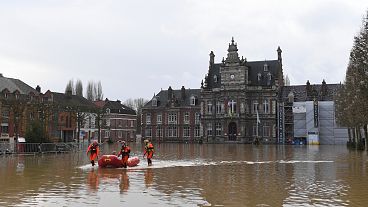Stroke prevention efforts should focus on high blood pressure, lifestyle, and environmental factors that can increase people’s risk, the study authors said.
The number of strokes worldwide has climbed since 1990, but Europe runs counter to the trend, according to a new global analysis.
Stroke was the third-leading cause of death in 2021 – after heart disease and COVID-19 – killing 7.3 million people globally and 967,000 people in Europe. In all, 11.9 million people had a stroke that year, estimates show.
While the global stroke burden has surged over the past three decades, it hasn’t been felt equally in every region.
Incidence and deaths are highest in low-income countries and lowest in high-income countries, and the key risk factors differ as well, according to the study published in the Lancet Neurology journal.
Metabolic versus environmental risk factors
"The global growth of the number of people who develop stroke, and died from or remain disabled by stroke is growing fast, strongly suggesting that currently used stroke prevention strategies are not sufficiently effective," Dr Valery Feigin, director of the Auckland University of Technology’s National Institute for Stroke and Applied Neuroscience (NISAN) and the study’s lead author, said in a statement.
Feigin’s team mapped out how risk factors such as air pollution, smoking, behaviour, diet, environmental factors, and metabolic issues affect the global burden of three types of stroke: ischaemic stroke, intracerebral haemorrhage, and subarachnoid haemorrhage.
Metabolic risks contributed to 68.8 per cent of all strokes, while environmental risks made up 36.7 per cent and behavioural risks constituted 35.2 per cent.
Between 1990 and 2021, certain risk factors became more important drivers of poor health after stroke, including high body mass index (BMI) and blood pressure, low physical activity levels, and diets that are high in sugar and low in omega-6 fatty acids.
Warmer weather is also a growing contributor to stroke. High heat and dehydration can thicken the blood, raising the risk of stroke-causing clots, and can exacerbate problems like high blood pressure.
The risks differ by region. Rising obesity levels, type 2 diabetes, and high blood pressure among young adults are driving the increases in poor health tied to stroke in low-income parts of Asia and sub-Saharan Africa, the study found.
Strokes in Europe on decline
Notably, the stroke burden has fallen in Europe over the past three decades. Death rates are down by 68.3 per cent in Western Europe, 55.3 per cent in Central Europe, and 43.3 per cent in Eastern Europe.
At the country level, declines in stroke mortality rates ranged from 1.8 per cent in North Macedonia to 80.4 per cent in Portugal, the analysis shows.
That trend is likely to continue. Using the same database in 2020, researchers from King's College London projected that stroke deaths in the European Union will drop by 17 per cent by 2047, though a few Eastern European countries may see small increases.
However, they also expect the prevalence of strokes to rise by 27 per cent in the EU, driven largely by ageing populations and improved survival rates.
That means more Europeans will be living with the health consequences after a stroke, which can include fatigue, difficulty balancing, and weakness or paralysis on one side of the body.
In Europe, the top risk factors for stroke are high blood pressure and high cholesterol, the analysis found, but air pollution is also a top 10 risk factor, particularly affecting Central Europe.
"Given that ambient air pollution is reciprocally linked with ambient temperature and climate change, the importance of urgent climate actions and measures to reduce air pollution cannot be overestimated," Dr Catherine O. Johnson, a study co-author and lead research scientist at the US-based Institute for Health Metrics and Evaluation (IHME), said in a statement.
Last year, the European Environment Agency (EEA) said that government action is necessary to curb the environmental risks tied to stroke and other cardiovascular issues.
"We do not need to fully understand every step of the causal pathway from environmental exposures to cardiovascular disease cases to take decisive action to reduce pollution," the agency says.
Meanwhile, Feigin said doctors can shift some stroke prevention work to nurses and health volunteers, and use telehealth platforms in order to reach patients more broadly.
In order to "address the critical gaps in stroke service delivery, workforce capacity building, and epidemiological surveillance systems must be urgently implemented across all countries," he said.















